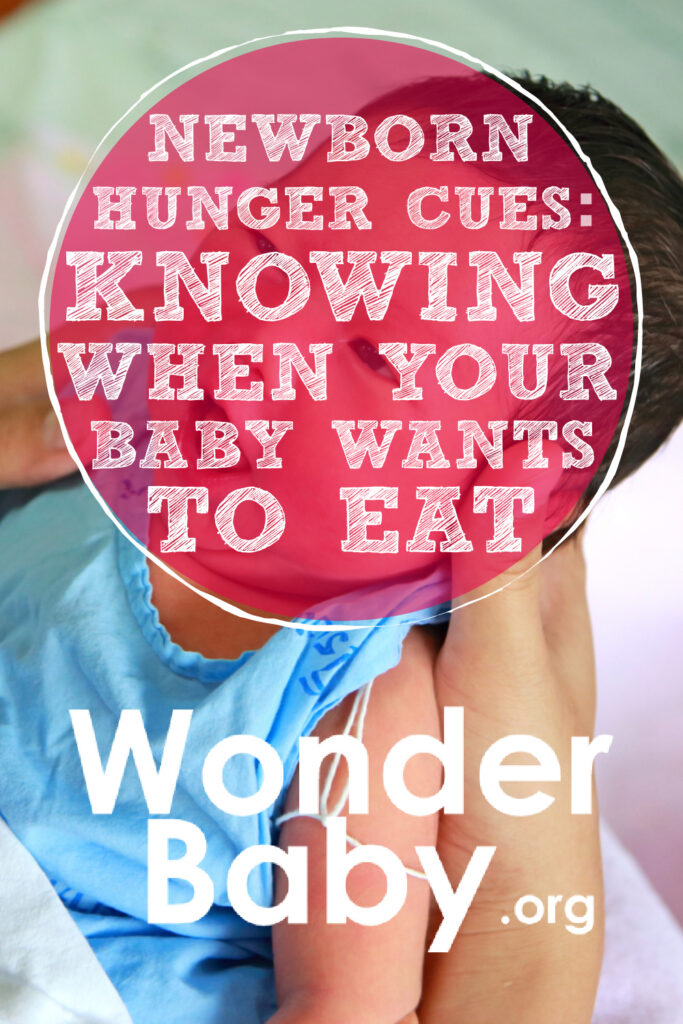Newborn Hunger Cues: Knowing When Your Baby Wants To Eat

- Babies can communicate with us long before they learn how to talk. Each time you respond to your baby’s early attempts at communication, you’re encouraging them to keep communicating their needs with you.
- As you and your baby get to know each other, you will begin to recognize their feeding cues. You may even do this subconsciously.
- Responding to early cues can give a big confidence boost to new parents. Knowing you have understood your baby’s hunger cues and responded accordingly will make you feel proud of your parenting prowess.
- Hunger cues include rooting, lip-smacking, and fussing.
- These cues change over time. As your baby grows, they may change the way they communicate their hunger with you.
Long before your baby learns to talk, they will communicate their needs with you. Though many people think babies communicate by crying, this is actually just one of the ways they communicate their needs. When it comes to newborn hunger cues, crying is a late hunger cue and is actually one of the last clues that your baby might be hungry.
By paying attention to your baby’s movements and facial expressions, you can figure out what your baby wants before they begin to cry. Not only will this make you feel like a Super Parent, but it will show your baby that you understand them.
As a new parent, feeding your baby will take up a lot of your time. Whether you’re breast or formula feeding your baby, your newborn baby will likely feed between eight and 12 times a day. Understandably, many new parents feel anxious about whether their baby is feeding often enough. Some parents worry about giving their newborn too much milk, while others fear their baby isn’t eating enough.
Though there are plenty of old wives’ tales out there about how to feed your baby, it’s important to get your information from a trusted source. Ignore the unsolicited parenting advice from neighbors, family members, and colleagues, and instead focus on evidence-based information from your healthcare provider.
What Are Newborn Hunger Cues?

Hunger cues are behavioral clues that your baby might be hungry. Your baby will exhibit early behavioral cues before they start crying. Noticing and responding to these cues means you can feed your baby before they start crying.
Some people think crying is the first clue your baby might be hungry, but in fact, your baby will exhibit lots of early hunger signs before they begin to cry. Responding quickly to your baby’s cues means your baby won’t need to become upset to get your attention.
How to Recognize Hunger Cues in Newborns
The more time you spend with your baby, the better you will be at recognizing their hunger cues. Don’t worry if you don’t recognize these cues at first; it takes time to master the subtle language babies communicate in.
Looking out for cues means you can feed baby before they start crying. A baby’s feeding cues are split into three stages: early, mid, and late.
| Early Hunger Cues | Mid Hunger Cues | Late Hunger Cues |
|
|
|
What is the Rooting Reflex?
The rooting reflex is present from birth until around four months. It’s the reflex that helps your baby find their way to the breast or bottle. If you gently stroke the corner of your baby’s mouth, they will turn their head towards your finger. If you notice this reflex, it’s likely an indication that your baby is hungry.
Once your child passes the newborn stage, their cues might change. For example, sucking their fist may not be a reliable hunger cue by the time they’re six weeks old. Babies often suck on their hands when they’re teething, so this may not indicate hunger from around six weeks.
Why Is It Important to Recognize Newborn Hunger Cues?

Recognizing hunger cues and feeding your baby responsively will make your life easier. Firstly, it’s much trickier to feed a baby who is upset. Secondly, your baby’s feeding cues are an early attempt at communication with you. Each time you respond to your baby like this, you’re reassuring them that they’re understood and that you’re there to meet their needs.
Recognizing feeding cues and feeding your baby whenever they exhibit these cues is an easy way to ensure your baby is getting enough milk. If you’re breastfeeding, responsive feeding has the additional advantage of ensuring your body continues to produce enough milk.
What Are the Consequences of Ignoring Signs of Hunger in Newborns?
If you miss the early cues, your baby is likely to start crying. Once your baby is upset, you may find it harder to get them to feed. If you’re breastfeeding, it can be difficult to latch an unhappy baby, but even bottle feeding can be more difficult if your child is upset. You will likely need to soothe your baby before you can attempt to feed them.
Not only is it more difficult to feed a crying baby, but you may also find yourself feeling stressed when your baby is crying. Noticing and responding to early hunger cues saves you the stress of trying to soothe your baby’s cries.
Should You Feed a Newborn Every Time They Show Hunger Cues?

Yes, you should try to follow your baby’s feeding cues, as these are the best indication that your baby is hungry. Though some self-proclaimed experts may have you believe otherwise, newborns shouldn’t feed on a schedule.
Newborn babies go through growth spurts where you may notice they feed more frequently. During a growth spurt, your baby will need the extra milk, which is why feeding on demand is good for babies.
If you’re breastfeeding, regular feeds are important for building up your milk supply. Follow your baby’s feeding cues, and you should find your body responds by providing ample breastmilk.
Signs Your Baby is Full
As well as communicating their hunger to you, your newborn baby is capable of communicating when they’re done eating. Responsive feeding is about responding to your baby’s early attempts at communication when it comes to feeding. Paying close attention to your baby will help you spot these signs that your baby is full. When your baby finishes eating, they may:
- Release the breast or bottle.
- Turn their head away.
- Relax their hands.
- Fall asleep.
Generally, if you notice the above signs, it’s fine to stop feeding. In fact, doing so can teach your baby to listen to their body’s cues and stop eating when they aren’t hungry anymore.
If ever you feel concerned about your baby’s feeding patterns, you should speak to your child’s pediatrician for advice. They’ll be able to weigh your baby, ask questions about how often they feed, and hopefully reassure you that you’re doing a great job. Whether you’re formula feeding or breastfeeding, your pediatrician will be able to advise on your baby’s feeding patterns and general health.

Related Posts

Breastfeeding, Sleep
Sleep and Breastfeeding: A Comprehensive Guide for Nursing Moms
Many people assume breastfeeding and sleep training don’t go together, but it is possible to help your baby sleep better while continuing your breastfeeding journey.

Breastfeeding
Comfort Nursing: Pros, Cons, and How to Stop
Find out what comfort nursing is, when should you worry about it, and how to stop or limit your baby's comfort nursing (especially at night!).

Breastfeeding, Product Reviews
5 Best Breastfeeding Chairs for Nursing Moms of 2023
Whether you want a gentle rock, a smooth glide, or a cozy cuddle to soothe your baby to sleep, you’ll have your pick of the best breastfeeding chairs on the...